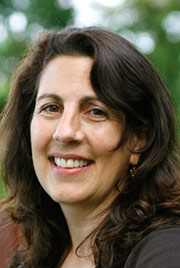Conservation across borders
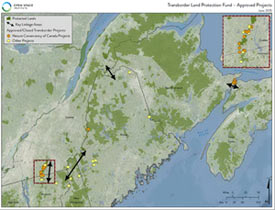
Transborder Land Protection Fund map (Photo by Open Space Institute)
With Canada Day just behind us and the coming of Fourth of July in our midst, Vice-president of Conservation Grants and Loans for the Open Space Institute, Jennifer Melville, recently got together with the Nature Conservancy of Canada's (NCC') Jill Murray to chat about conservation work around the Canada-U.S. border.
Jill: Jennifer, thanks so much for joining us today. Tell us a bit about yourself and the Open Space Institute.
Jennifer: The Open Space Institute, or OSI, was founded in 1974 to protect significant landscapes in New York State. We have evolved from those beginnings to partner in the protection of nearly 2.2 million acres (890,308 hectares) in North America, from Alabama up the spine of the Appalachians to southeastern Canada.
All of OSI’s work is directed by a consistent strategy emphasizing permanent protection on a landscape-level scale. Working with great partners – like NCC – and using sound science, we invest in the places most important for wildlife, clean drinking water, productive forests and farms and public enjoyment.
I’ve been working at OSI for nearly seven years and on land conservation for three decades. It is the enduring element of land protection – its tangible nature – that is so rewarding to me. Among my OSI projects, I oversee The Transborder Land Protection Fund, which has supported NCC’s conservation efforts since 2009.
Map of projects under OSI's Transborder Land Protection Fund >
Jill: So why is a U.S. organization investing in conservation in Canada?
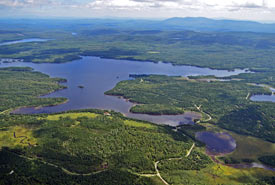
Lac du Portage, MB (Photo by Claude Duchaîne)
Jennifer: The name of one of our partners, Two Countries, One Forest, perhaps best sums it up. Canada and the U.S. are connected. We share resources – from air, water and forests, to migratory birds, bears, moose and Atlantic salmon. International boundaries are meaningless to the animals that migrate through North America’s lands and waterways yet sometimes these boundaries stand in the way of smart conservation.
Transboundary work considers natural boundaries – and the natural movement of plants and animals – instead of political borders. When you consider that the world’s largest broadleaf forest rests across four states and three provinces, the need to plan and act internationally becomes pretty clear.
OSI isn’t "investing in Canada" per say. Rather we are promoting a strategic approach to protecting wildlife. And that leads OSI to support conservation of key wildlife corridors, which often span the border. Thanks to the vision and generous support of the Partridge Foundation, OSI’s Transborder Land Protection Fund encourages conservation organization to work in this bigger context.
Jill: Why do you believe cross-border conservation is so important?
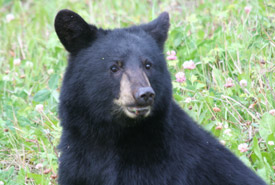
Black bear (Photo by NCC)
Jennifer: Those of us in the U.S. tend to think of Canada as a big expanse of wilderness. But when you actually look at a map, you see that the majority of Canada’s population is right up against the U.S. border. This can, and is, create an impediment to wildlife movement. From a U.S. perspective, the undeveloped land that is left in southern Canada is really important to the survival of plants and animals that depend on habitat on both sides of the border. As wildlife cope with the stress of a changing climate, its all the more important that animals and plants have room to move freely across the landscape.
Jill: What are wildlife corridors and why are they important?
Jennifer: Animals need a way to get from one area of forest to another. Because our forests are generally broken up by roads and houses and other development it is now harder for them to move around. Wildlife corridors enable animals to safely move from one forest block to another, to get access to the food, water and habitat they need to thrive. For example, black bears may den in Vermont but travel into Canada at others times of year for food or shelter.
Jill: Why does OSI support NCC’s work?
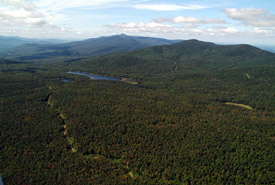
Green Mountains, Quebec (Photo by Claude Duchaîne)
Jennifer: Great land conservation planning work is key to why OSI supports NCC. NCC has undertaken important conservation planning in the Green and White mountains and the Three Borders region. This work helps OSI see how NCC’s acquisition targets fit into a larger context; these are not just one-off projects but are well planned and well thought out.
OSI also funds NCC because of the fantastic partnerships with local land trusts. NCC’s contribution to the communities in which it works, NCC’s sharing of conservation plans, NCC’s collaboration with local experts — all of these are great elements for enduring conservation.
Jill: Do you think cross-border, large-scale conservation is becoming more critical?
Jennifer: Climate change poses a whole new set of stressors for plants and animals. We don’t know how plants and animals will react or rearrange themselves on the land as the climate warms and as storms become more frequent.
It’s important to protect large, unfragmented areas to give animals the best chance of adapting to climate change. The more connected a landscape, the more landscape variation, the more microclimates, the better chance they have.
Jill: What are some of the Transborder Fund’s biggest accomplishments?
Jennifer: The biggest accomplishment is helping protect so many acres with fantastic partners – that’s tangible results. To date we’ve supported 20 projects contributing to permanent protection of 32,000 acres (12,949 hectares). But just as important, conservation organizations are increasingly considering the tranborder context of their efforts.
It doesn’t mean that NCC or the Vermont Land Trust, for example, are working on the other side of the border themselves, but they’re more aware of the connection between their projects and those across the international boundary. When I get a map from a conservation group and they have filled in the map on the opposite side of the border, that is a mini victory.
Jill: It's great to see funding organizations and conservation groups come together with a common goal in mind. Thank you Jennifer!

